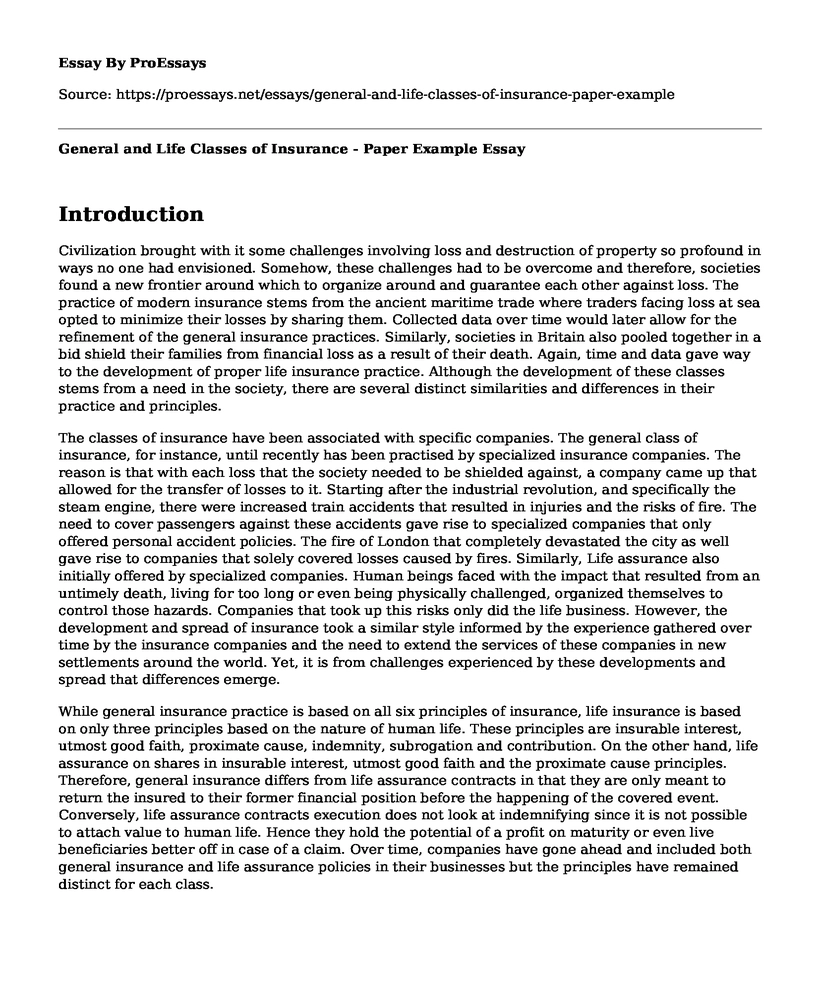Introduction
Civilization brought with it some challenges involving loss and destruction of property so profound in ways no one had envisioned. Somehow, these challenges had to be overcome and therefore, societies found a new frontier around which to organize around and guarantee each other against loss. The practice of modern insurance stems from the ancient maritime trade where traders facing loss at sea opted to minimize their losses by sharing them. Collected data over time would later allow for the refinement of the general insurance practices. Similarly, societies in Britain also pooled together in a bid shield their families from financial loss as a result of their death. Again, time and data gave way to the development of proper life insurance practice. Although the development of these classes stems from a need in the society, there are several distinct similarities and differences in their practice and principles.
The classes of insurance have been associated with specific companies. The general class of insurance, for instance, until recently has been practised by specialized insurance companies. The reason is that with each loss that the society needed to be shielded against, a company came up that allowed for the transfer of losses to it. Starting after the industrial revolution, and specifically the steam engine, there were increased train accidents that resulted in injuries and the risks of fire. The need to cover passengers against these accidents gave rise to specialized companies that only offered personal accident policies. The fire of London that completely devastated the city as well gave rise to companies that solely covered losses caused by fires. Similarly, Life assurance also initially offered by specialized companies. Human beings faced with the impact that resulted from an untimely death, living for too long or even being physically challenged, organized themselves to control those hazards. Companies that took up this risks only did the life business. However, the development and spread of insurance took a similar style informed by the experience gathered over time by the insurance companies and the need to extend the services of these companies in new settlements around the world. Yet, it is from challenges experienced by these developments and spread that differences emerge.
While general insurance practice is based on all six principles of insurance, life insurance is based on only three principles based on the nature of human life. These principles are insurable interest, utmost good faith, proximate cause, indemnity, subrogation and contribution. On the other hand, life assurance on shares in insurable interest, utmost good faith and the proximate cause principles. Therefore, general insurance differs from life assurance contracts in that they are only meant to return the insured to their former financial position before the happening of the covered event. Conversely, life assurance contracts execution does not look at indemnifying since it is not possible to attach value to human life. Hence they hold the potential of a profit on maturity or even live beneficiaries better off in case of a claim. Over time, companies have gone ahead and included both general insurance and life assurance policies in their businesses but the principles have remained distinct for each class.
Conclusion
In conclusion, while the insurance industry developed to cater to societal needs, its development and spread resulted in major differences in the practice of each class of insurance. The origins, early development, and practice followed the same lines but the experiences of these companies resulted in insurance principles from which the major differences in the classes of insurance rise.
Cite this page
General and Life Classes of Insurance - Paper Example. (2022, Jul 18). Retrieved from https://proessays.net/essays/general-and-life-classes-of-insurance-paper-example
If you are the original author of this essay and no longer wish to have it published on the ProEssays website, please click below to request its removal:
- The Superior Capital Budgeting Methodology
- Hotel Liability Essay
- Analysis of the Risk and Value Implication for Capital Structure Issues Essay
- Essay Sample on Differences Between the ADB, WB and IMF
- Essay Example on Investing in Stocks: Benefits and Risks of Financial Gains
- Impact of IMF, WB on Municipal Finances - Essay Sample
- Independent Audit Report - Free Sample







